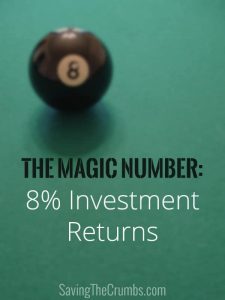Perhaps the single question I’ve been asked the most in relation to this blog has been, “Where in the world is it possible to get 8% returns on my investments?!”
It’s true, I’ve mentioned this figure multiple times in the past and have even referenced it as a benchmark for healthy investment returns. So for anyone who’s ecstatic to get a 2% interest rate on his or her savings account, 8% certainly seems an impossible reach and would no doubt raise the same question everyone’s been asking. So while there aren’t any investments that will GUARANTEE an 8% return, there certainly are some that have great PROBABILITY of reaching it. I’ll share a few of them later in this post.
But first, we need to build a little foundation.
Why 8%?
From 1871 to 2013, the S&P 500 (a stock market index tracking the 500 largest companies in the US) has had an average annual return (including both appreciation and dividends) of 10.75%. But this number is slightly misleading. For example, if I invested $100 and the market dropped by 50% in the first year, I would have $50 left. Then if the market went up 50% the next year, I would now have $75, NOT $100 even though the simple averaging of those two percentages would show a 0% change over the two years. In actuality I had a DECREASE of 25%! That’s no joke! So the simple average (or “arithmetic mean”) of the S&P 500 over a long period of time isn’t accurate for our purposes, what we need to look at instead is the “annualized return” or “compound annual growth rate” or CAGR for short. So for the same time period of 1871 to 2013, the CAGR for the S&P 500 is actually 9.07%.* So after rounding down a bit for fees and expenses associated with investing, we arrive at 8% as a working number for our calculations. (Note: This is NOT inflation-adjusted. We do this so we’re comparing apples with apples when we discuss other interest rates, which also aren’t inflation-adjusted numbers.)
So this historical trend of the stock market is why I use 8% as my yardstick for measuring investment returns, even though I hasten to add that past results may not predict future performance. Here I should also make clear that 8% is a rate of return to be expected over a long time horizon. In fact you would probably find very few years where the stock market ended with exactly 8% gains. There may be years of 50% drops and other years of 25% gains, but over the course of time, the average as leveled out to a continuously upward trajectory.
Some of you may feel queasy about the prospect of losing money in something as fickle as the stock market in search of the elusive 8% yield. However, as we discussed in a previous post on investment risk, the risk of losing money in an account that lags the rate of inflation (or worse, hiding it in your mattress!) is actually a 100% risk over time. You are GUARANTEED to lose your buying power eventually because of the erosive effects of inflation. Yet it is true that volatility will always go up as the prospective rate of return goes up as well. In short, there is no such thing as a NO RISK investment. (Paying off your debts would be the closest thing.) The best we can do is to mitigate risk by selecting investments that balances the volatility of sudden changes in value with keeping ahead of inflation. Since inflation has averaged somewhere around 3-4% annually, we will need a yield of at least 4% to tread water, and definitely above 4% if our long-term investments are to grow.
So this is why I believe 8% is a reasonable target for investments. It’s high enough to beat inflation and taxes even if I miss by a few percentage points (always a possibility), but yet it’s conservative enough to not require irrational or speculative risk to attain.
Don’t Forget Everyday Investing
Before we get into some of the specific investments, I want to point your attention to a previous post called Everyday Investing where I outlined a number of ways where you can easily surpass 8% yield without dabbling in stocks or anything like that at all. One thing I mentioned specifically was paying off consumer debt. Seriously, I wouldn’t recommend investing in anything else until your consumer debts are 100% paid off. It will almost always be your best investment.
Here are three types of investments that I have personally used that have high potential to generate +8% returns.
Three Options
1. Mutual Funds/Index Funds/Exchange Traded Funds (ETFs)
Mutual funds (and their newer relative, the exchange traded fund or ETF) are investment vehicles where investors pool their resources to own a bucket of assets together. They are typically stocks, but could be bonds, commodities, or any combination of things. There are actively managed mutual funds where a fund manager is responsible for creating the investment portfolio and there are index funds which passively track a pre-determined index by matching its portfolio to the make-up of said index.
I prefer index funds. They have lower management costs, lower tax liability, and they track an index so you know exactly what it’s doing. (So I can essentially replicate the S&P 500 by simply buying an S&P 500 index fund.) Actively managed funds cost a lot more to operate and have not proven to consistently outperform index funds. For people interested in stock market investing, index funds/ETFs would be my first recommendation. However, as with all stock market investments, you should get in only if you plan to hold for a long time horizon, preferably 5 years or longer. It’ll give you enough time to ride out the ups and downs of the market.
A lot of ink has been spilt on the topic of stock market investing and mutual funds. For those with an interest in such things, here are two free online resources that I would recommend for your further research:
- Bogleheads: Jack Bogle pioneered index fund investing on the fundamental belief that you can’t outsmart the market and you’ll get farther ahead by simply reducing the costs of investing. (Transaction fees, management fees, taxes, etc.) In a real way, he made the stock market easy for the simple guy. (Like me!) The Bogleheads website is a gathering place for a community of like-minded investors inspired by the principles of Jack Bogle, and it’s a place where you will find loads of information on investing philosophy. If you’re brand new, I would recommend starting with the introductory video series on investing.
- JL Collins Stock Series: JL Collins is a disciple of Jack Bogle’s philosophy, and his ongoing series on the stock market is one of the most succinct and best distillations of stock market investing I’ve read anywhere. He’s got good research to back up what he says, all while packaging it in an extremely easy-to-read manner. If you are interested in stock market investing, but have absolutely NO CLUE where to start. Just start here.
2. Peer-to-Peer Lending
This is a relatively new form of investing where investors loan money directly to other human borrowers, with the transaction being brokered by an organization in the middle that takes a small cut of each transaction. It is uncorrelated to the stock market, which is good for diversification purposes. The process is quite straightforward and it is very possible to get 8% or more. The primary risk is simply whether the person will pay you back (default risk), so you can spread out your loans across multiple borrowers to mitigate against this risk. (Starting loans can be as low as $25.)
The two companies that I’m familiar with are Lending Club and Prosper. Both of them work in the same way where you create an account, transfer money into that account, and then simply review applications for loans and you choose who you’d like to loan to. With a few clicks, you’re done. The companies handle the transactions, they spell out the rates and the descriptions for you in an easy-to-navigate format. Once you issue your loan, they handle the collection of the payments each month and deposit your share monthly into your account. It’s quite painless and simple. Ever wish you could be on the benefiting end of a loan instead of the bank? Now you can! (Just be sure to check if you qualify to participate because it is not available in every state.)
3. Rental Real Estate
Real estate is probably one of the most tried and true forms of investment available. It’s a physical asset that everybody understands. There are different forms of real estate investing from buying and holding land, to commercial development, to flipping foreclosures, to building skyscrapers, but most common is simply rental properties. With a good initial purchase price and a competitive market, rental properties can easily net you more than 10% returns plus open the doors to tax incentives. We have a guest house on our property which we makes us over 11% returns based on our conservative estimates.
One downside for real estate is that you typically need a large initial amount of capital to get in. It’s hard to buy a rental property with only $100, so you may need to invest using some other means first and move into real estate once you’ve built up a big enough crumb stash. Be patient with this one because as with most types of investments, it’s crucial to buy in at the right price.
Understand First, Invest Later
In closing, I need to make clear that this post barely scratches the surface on the subject and isn’t intended as professional investing advice, so be sure to do your due diligence before putting your money to work in any of these things.
Always remember:
DON’T invest in anything that you don’t understand. DON’T forget that there’s no such thing as a no-risk investment. DON’T invest until you have paid off your debts and have emergency savings.
But DO study, DO learn more, and DO plan to invest!
*You can play with this calculator to check out the historical performance of the S&P 500 for yourself.







